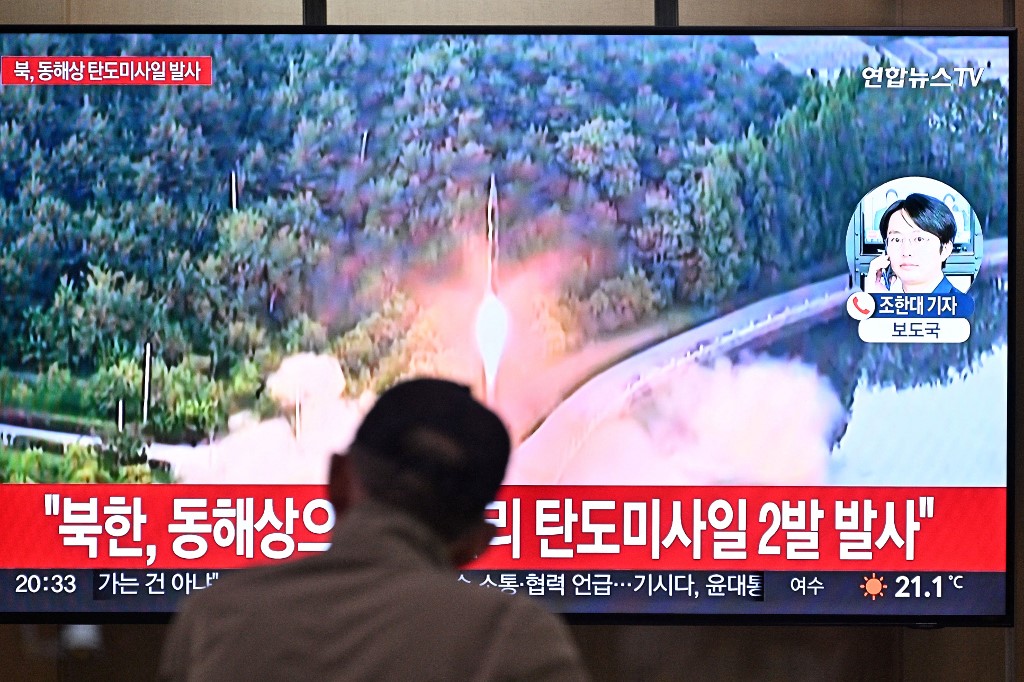North Korea fires two short-range ballistic missiles

A man watches a television showing a news broadcast with file footage of a North Korean missile test, at a railway station in Seoul on June 15, 2023. (Photo by Anthony WALLACE / AFP)
SEOUL, South Korea — North Korea fired two short-range ballistic missiles, South Korea’s military said Thursday, shortly after Pyongyang warned of an “inevitable” response to ongoing US-South Korea joint military drills.
South Korea and the United States, which have ramped up defense cooperation in response to growing threats from the nuclear-armed North, are currently carrying out joint large-scale live-fire “annihilation” exercises.
Seoul’s Joint Chiefs of Staff said it had detected the launch of “two short-range ballistic missiles from the Sunan area into the East Sea between 19:25 and 19:37,” referring to the body of water also known as the Sea of Japan.
“We have stepped up monitoring in case of further provocations and are maintaining readiness in close coordination with the United States,” the military said.
Tokyo also confirmed the missile launches, with a defense ministry official telling reporters that the two missiles had landed in waters within Japan’s exclusive economic zone.
Article continues after this advertisement“The missiles may have flown on irregular trajectories,” Japan’s top government spokesman Hirokazu Matsuno told reporters, adding that one had flown 850 kilometers and the other around 900 kilometers at altitudes of 50 kilometers, before landing in Japan’s EEZ.
Article continues after this advertisementIn a joint statement, the United States, South Korea, and Japan condemned the launches, saying they violated UN Security Council resolutions and demonstrate the threat “unlawful weapons of mass destruction and ballistic missile programs pose to the region.”
And in a separate move, Washington on Thursday imposed sanctions against two North Koreans based in Beijing over their alleged connection to Pyongyang’s weapons program.
“The DPRK’s development of its missile programs directly threatens regional and international security, and the United States will continue to take action to curtail activities in support of those programs,” State Secretary Antony Blinken said in a statement, using the acronym for North Korea’s official name.
‘Inevitable’ response
Relations between the two Koreas are at one of their lowest points in years, with diplomacy stalled and the North’s leader Kim Jong Un declaring his country an “irreversible” nuclear power, as well as calling for ramped-up weapons production, including tactical nukes.
North Korea has conducted multiple sanctions-busting launches this year, including test-firing its most powerful intercontinental ballistic missiles, and last month attempting to put a military spy satellite into orbit.
In response, the hawkish administration of South Korean President Yoon Suk Yeol has bolstered defense cooperation with the United States and Japan, including expanding joint drills, which had been scaled back because of Covid-19, and during a bout of ill-fated diplomacy.
Yoon personally watched South Korean and US troops take part in the live-fire exercises Thursday.
All such drills infuriate Pyongyang, which regards them as rehearsals for invasion.
North Korea slammed the drills, saying they were escalating military tensions in the region.
“Our response to this is inevitable,” the defense ministry said in a statement Thursday carried by the official Korean Central News Agency. “Our armed forces will fully counter any form of demonstrative moves and provocation of the enemies.”
Lawsuit
On Wednesday, South Korea filed a lawsuit seeking damages from North Korea for the 2020 demolition of a liaison office.
The office was established in 2018 with funding from Seoul at an industrial zone near the border in North Korean territory, as South Korea’s then-president Moon Jae-in pressed for a diplomatic breakthrough with Pyongyang.
But after that process collapsed and relations deteriorated, North Korea demolished the building in June 2020.
Seoul describes the demolition as a “clearly an illegal act” and is seeking 44.7 billion won ($35 million) in damages.
North Korea is likely to ignore any ruling by the court, but there is precedent in South Korea and the United States for damages being awarded against its government.
“Given the timing, the launch seems like the North’s expression of discontent or protest at Seoul’s legal action seeking compensation (for) the North’s demolition of the Kaesong office,” Choi Gil-il, professor of military studies at Sangji University, told AFP.
READ: North Korea fires two ballistic missiles, says Seoul’s military